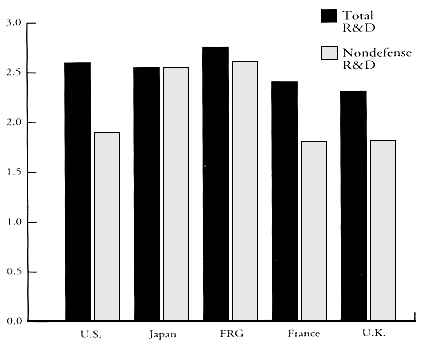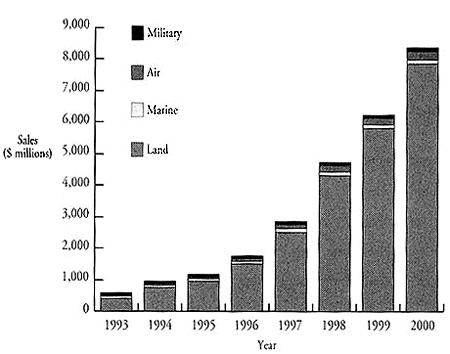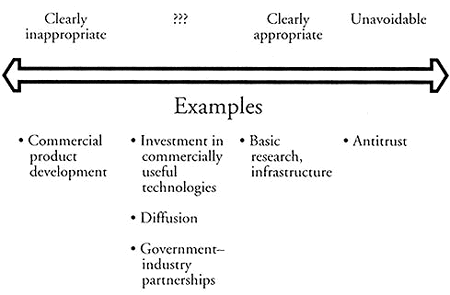|
|
|
|
Science Technology and the Economic Future edited by Susan Raymond
Stephen M. Drezner
Director, Critical Technologies Institute, RAND
Based on remarks delivered at the New York Academy of Sciences, May 24, 1995.
Dual-use technology strategies are underpinned by two important, complementary rationales. On the one hand, dual-use strategies are seen as combining the best commercial technologies and capabilities with defense systems design expertise to produce necessary military technologies more quickly and at a lower cost than has characterized defense technology R&D in the past. On the other hand, such strategies are seen as reinforcing and strengthening the link between defense research and development expenditures and the nation's overall commercial performance and economic growth.
Attractive though both of these arguments are, each encounters difficulties on the road between the theory and the practice of integrating military and civilian technology development.
The Reality Driving Dual-Use Strategies
From the defense perspective, the current period of budget reductions clearly implies a decline in defense-specific research and development resources. But the demand for advanced technologies by the military—both for weapons systems improvements and for enhanced efficiency—will continue. Hence, defense R&D will need to become more involved in the global networks that currently dominate commercial enterprises. Reliance on the commercial sector will be essential to getting better products developed faster at lower cost. This link between the nation's defense and its commercial capability is not optional, it is mandatory.
Why is this so? In part, the answer can be seen in the composition of R&D resources in the United States relative to its global competitors. Viewed in terms of the distribution of defense and non-defense spending for R&D the U.S. is unique in the defense component of its R&D spending pattern, spending many times more than its industrial competitors. Viewed relative to economic activity, however, the picture changes (see Figure 1). U.S. total R&D investments resemble those of Japan and Germany, and the ratio of defense-related R&D resembles that of France and Britain. The R&D pattern of the U.S. is becoming similar to that of its economic competitors.

|
|
Figure 1. Proportion of non-defense R&D to total R&D as percentage of GDP. Source. Critical Technologies Institute, 1995. |
Moreover, the roles of the commercial and defense sector in the advancement of technology have also shifted. Decades ago, it was defense R&D spending that led to technological advances. Today, in every technology area in which it is involved, the commercial sector is the leader. Defense technology is a leader only in those areas in which it is unique. To a large degree, commercial advances have out paced those of the defense sector because cumbersome, often needless, military specifications and cost accounting systems have so slowed the research and development process that it cannot keep pace with its commercial counterparts.
Three Questions and an Illustration
Against this background of change, three critical questions for dual-use technology must be answered. First, how can the nation's defense system maintain its technological edge when the global marketplace can access the very same technology as the U.S. military? Second, can the military sector build its capabilities and systems around commercial technology? And, third, what is the link between a dual-use technology strategy and the economic competitiveness of the United States? The nature of and answers to these questions require constant vigilance because the nation's security depends on maintaining technological superiority. An example of the importance of the military-civilian technology interface will illustrate the importance of the issue.
The Global Positioning Satellite (GPS) system is used by both the military and civilian sectors for navigation. The 24 satellites act like a global lighthouse and are available to anyone who has the land receiver to use their signals to determine land, sea, or air location. The system has become predominantly commercial (see Figure 2), with the commercial market for receivers predicted to | far out-pace that of the military by the year 2000. But, the military implications are clear. The wide availability of the receiver technology will increase any enemy threat to the U.S. military. The more sophisticated the missile system facing the U.S. military, the greater the marginal value the GPS system will provide the enemy. The more widely available the commercial capability, the more accessible those marginal values will be.

|
|
Figure 2. Global Positioning Satellites: Total U.S. sales. Source: U.S. GPS Industry Council, March 1995. |
Clearly, then, rapid commercialization of a technology results in loss of military control of that technology. On the other hand, there are clear defense benefits to commercial availability. In Operation Desert Storm, for example, the U.S. military did not have sufficient receivers in stock to meet the operation's needs. The military GPS receiver weighed 17 lbs., cost $34,000, and required 18 months to build. Faced with a shortage, the military bought receivers from the commercial supplier. Each commercial receiver weighed 3 lbs. and cost $1,300. There were differences, of course, in technical capacity, but the contrast is still striking. Parenthetically, by using best industry practices, the military has been able to reduce its unit cost to $1,200. The commercial unit now costs $800.
Maintaining a Technological Edge
The commercial and military sectors will share technology under a dual-use strategy. The technological edge will not come from controlling technology but from changing the parameters of the interface between technology and military needs. There are three dimensions to that change.
First, the military must try to ensure that U.S. commercial technology gets to market faster. In the past, complex software systems might take ten years to design. But the world did not stand still, and the software would be obsolete by the time the weapons entered production. Thus military cooperation with commercial developers is critical.
Second, the military will need to develop ways to better utilize technology. New systems for integrating technological advances into military needs, as well as improved approaches to training, are required. Finally, the military will need to use technology to improve the process involved in national defense. Information systems, modeling, and simulation can greatly benefit from commercial technological advances.
Military Requirements versus Commercial Resources
Goal conflicts in dual-use strategies are inevitable. The cost versus performance ratios that are acceptable in thinking about promoting competitive advantage may not be so acceptable when the goal is to defend the country. Merging the defense and commercial technology base of the United States will raise such conflicts.
If weapons systems are going to be based on commercial technology, then how will government influence the R&D underlying that technology so that military requirements will be met? Resolving this conflict will require a top-to-bottom transformation of the current military system for relating to the commercial sector. The military will need to begin to pro-actively design systems that can use commercial components. In turn, this will require not simply a change in procurement systems, but changes in the entire culture of the Department of Defense. The defense sector will no longer have the luxury of controlling its own industrial infrastructure. A commercial technological interface will not be a preference in weapons design, it will have to be a requirement. In turn, this will mean that the military will need to be concerned about the state of the nation's technological capacity not only in research, but also in product development and, ultimately, production.
It will take time and resources to change the culture of defense. Productivity in the military will change in complex ways, and the associated learning curves will have hidden costs. Fortunately, the leadership of the U.S. military is committed to change, and is even working with such corporations as Motorola and General Motors to understand the nature and process of organizational change so that the defense process will benefit from organizational experiences elsewhere.
Dual-Use and National Economic Competitiveness
Although the Department of Defense's share in total U.S. R&D has been declining, national security R&D continues to play a very large role in the total R&D budgets. In 1996, budgets for military basic research, applied research, and development, total over $37 million out of a total national R&D price tag of $70 million. How that money is spent, however, tells the tale of its importance. Of the nation's 199(1 $41.~ million budget for technology development, $32.(1 million, or 78 percent, will emanate from the defense sector.
Hence, the link between military expenditures and the nation's technological (and thus economic) superiority appears to be fundamental. However, that relationship is much more difficult to measure than to posit. Trying to determine with any confidence the fraction of total factor productivity (or any other output measure) attributable to technology has proved to be daunting. Moreover, the technological factor pales in comparison with other elements, such as management and marketing, in much industrial analysis.
The relative productivity of government-funded versus privately funded R&D has also been questioned. In the view of some analysts, defense R&D spending is critical to maintaining America's position in world technology. To others, the investment returns on government-sponsored R&D are so much lower than the returns to private R&D investments, that the economic rationale for maintaining defense capacity is undermined.
Dual-Use Within Broader Technology Policy
A dual-use strategy is only one, albeit crucial, element in a broader set of technology policies. Dual-use policy focuses on a somewhat narrow set of industries (e.g., aerospace, electronics, and information processing), and spin-offs that benefit the nation's overall economic health may be limited. U.S. technology. strategy obviously needs a more comprehensive approach.
As in many other debates, however, the critical problem in crafting such a multi-dimensional approach to linking technology to economic growth turns on the role of government policies and programs. A variety of federal policies shape commercial technology. These policies can be arrayed along a spectrum as displayed in Figure 3. In some areas, such as antitrust or intellectual property standards, the federal role is not only appropriate, it is unavoidable. On the other end of the spectrum (e.g., commercial markets), federal involvement is clearly inappropriate.

|
|
Figure 3. Federal policies shaping commercial technology. Source: Critical Technologies Institute. |
As always, it is the grey area in the middle that sparks debate. Support for basic research infrastructure for research on pre-competitive generic technologies has recently been seen as an appropriate area for federal support. But such areas of agreement are few. Commercial investments, technology diffusion, and government-industry partnerships for technology development all are under heavy, often impassioned debate. The ultimate result of that debate will determine the nature of federal technology policy well into the future.